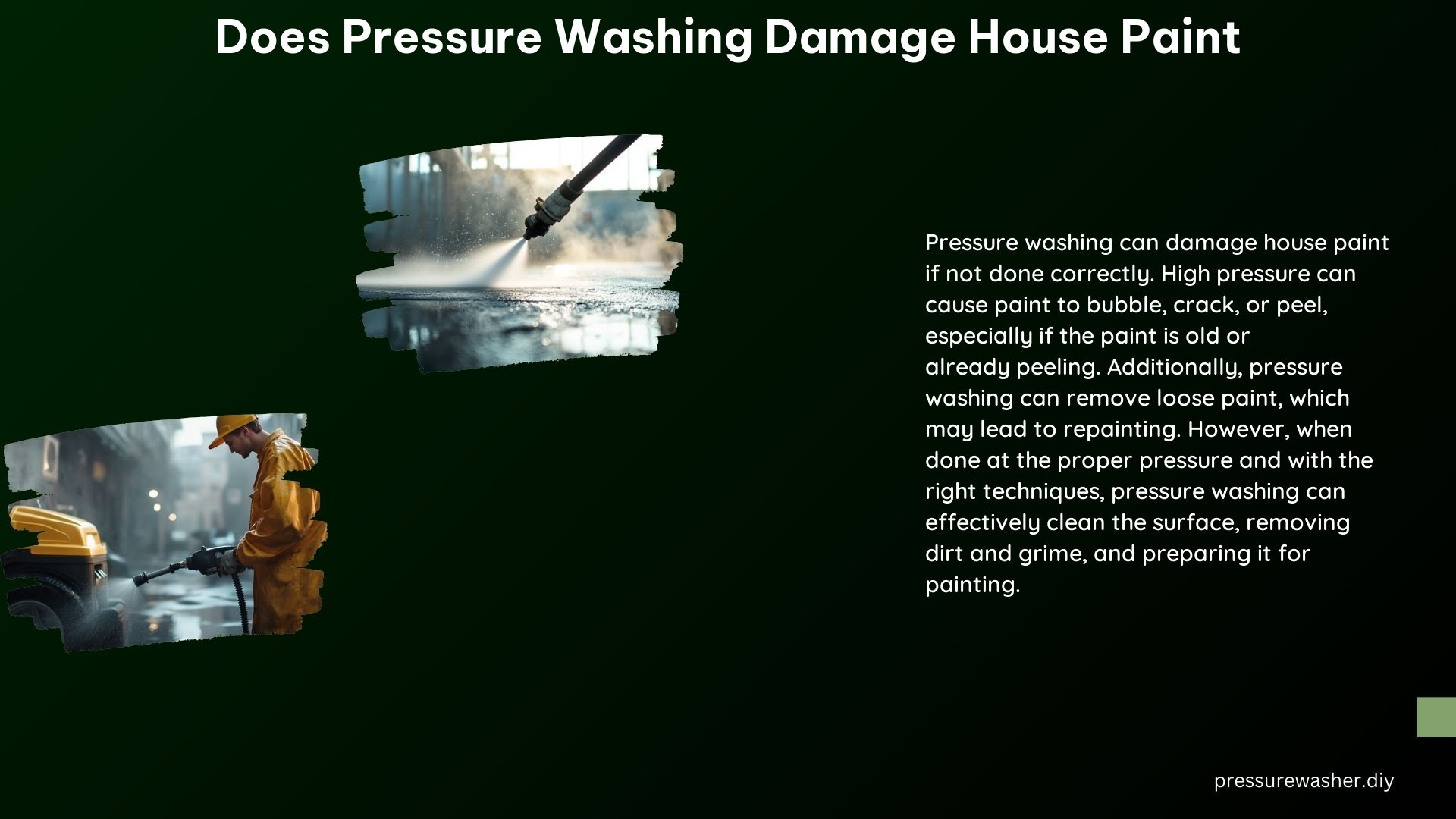Pressure washing can be an effective way to clean the exterior of your home, but it can also potentially damage the house paint if not done correctly. This comprehensive guide will provide you with a detailed understanding of the risks associated with pressure washing house paint, as well as the precautions you can take to avoid damaging your home’s exterior.
Risks of Pressure Washing on House Paint
Damage to Siding
Pressure washing can cause significant damage to siding, especially if the pressure is set too high or the technique is not properly executed. High-pressure water can knock siding loose, and the mortar on brick houses can be blasted away, leading to costly repairs.
The force of the water can be as high as 4,000 PSI (pounds per square inch) on some pressure washers, which is more than enough to damage even the sturdiest siding materials. Vinyl siding, in particular, is susceptible to cracking and warping under high-pressure water.
Removal of Paint
Pressure washing can also remove paint, especially if the paint is already peeling or loose. This can lead to the need for a complete repainting of the house, which can be a time-consuming and expensive process.
The water pressure can penetrate into the small cracks and crevices of the paint, causing it to lift and peel off the surface. This is particularly problematic for older homes with multiple layers of paint, as the pressure washing can remove the top layers and expose the underlying paint, which may be in poor condition.
Water Damage
If the pressure washer is used at too high a pressure, water can get into the walls and cause significant damage, including soggy carpets, wet attics, and the growth of mold and mildew. This type of water intrusion can be difficult and costly to repair, and it can also lead to long-term structural issues if left unaddressed.
The high-pressure water can force its way through small cracks and gaps in the siding, allowing it to penetrate deep into the wall cavities and potentially causing water damage to the home’s interior.
Precautions to Avoid Damaging House Paint

Use the Right Nozzle
To avoid stripping away loose paint, it’s essential to use a 15 or 25-degree nozzle on your pressure washer. These wider-angle nozzles are better suited for cleaning without causing damage to the paint. Narrower nozzles, such as the 0 or 15-degree options, should be avoided as they concentrate the water pressure into a more focused stream, which can be more likely to remove paint.
Work from Top to Bottom
When pressure washing your home, it’s important to start from the top and work your way down. This will prevent dirty water from dripping onto the already-cleaned areas, which can leave unsightly streaks or stains.
Avoid Sensitive Objects
Be sure to keep the pressure washer nozzle away from windows, lights, and other sensitive objects on your home’s exterior. The high-pressure water can easily crack or shatter these delicate surfaces, leading to costly repairs.
Don’t Linger
Avoid lingering too long on any one spot while pressure washing, as this can cause gouging or damage to the siding. Instead, keep the nozzle moving in a steady, even motion to ensure a consistent clean without causing any localized damage.
Use Low Pressure
For delicate surfaces like wood or vinyl siding, it’s crucial to use low-pressure settings on your pressure washer. High-pressure settings should be reserved for tougher stains and concrete surfaces, where the increased pressure is necessary for effective cleaning.
Hire a Professional
If you’re unsure about how to properly pressure wash your home without causing damage, it’s best to hire a licensed, professional contractor who has the knowledge and experience to do the job correctly. They will have the right equipment, techniques, and safety protocols in place to ensure your home’s exterior is cleaned without any unwanted consequences.
Technical Specifications
Pressure Washer Types
There are two main types of pressure washers: gas-powered and electric. Gas pressure washers are generally more powerful and effective for large areas like house exteriors, with the ability to generate up to 4,000 PSI of water pressure. Electric pressure washers, on the other hand, are typically better suited for smaller jobs and have a lower maximum pressure, usually around 2,000 PSI.
Nozzle Angles
As mentioned earlier, 15 and 25-degree nozzles are the recommended choices for cleaning house exteriors without damaging the paint. These wider-angle nozzles spread the water pressure out over a larger surface area, reducing the risk of stripping away the paint.
Pressure Settings
When pressure washing a house, it’s essential to use the appropriate pressure settings for the task at hand. Low-pressure settings, around 500-1,000 PSI, are recommended for delicate surfaces like wood or vinyl siding to avoid causing any damage. Higher-pressure settings, up to 4,000 PSI, can be used for tougher stains and concrete surfaces, but should be avoided on the painted areas of the home.
References
- https://blog.puls.com/how-to-pressure-wash-a-house
- https://www.reddit.com/r/HomeImprovement/comments/wal6no/guy_thats_gonna_paint_my_house_says_he_pressure/
- https://www.pressurewashersdirect.com/stories/1383-How-and-Why-to-Pressure-Wash-Before-Painting-Your-House.html
- https://www.trottaspowerwashing.com/blog/should-i-power-wash-my-house-before-painting-it/
- https://newlifepainting.com/blog/everybodys-doing-it-should-you-pressure-wash-your-house/
